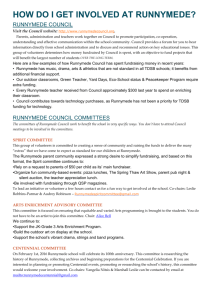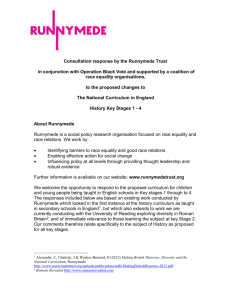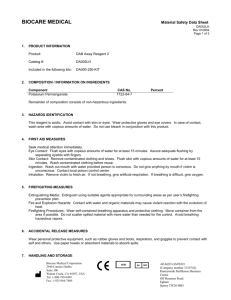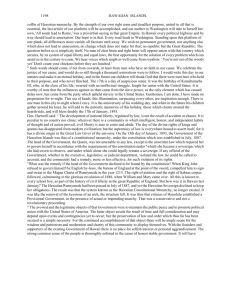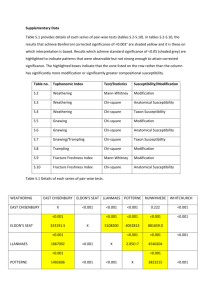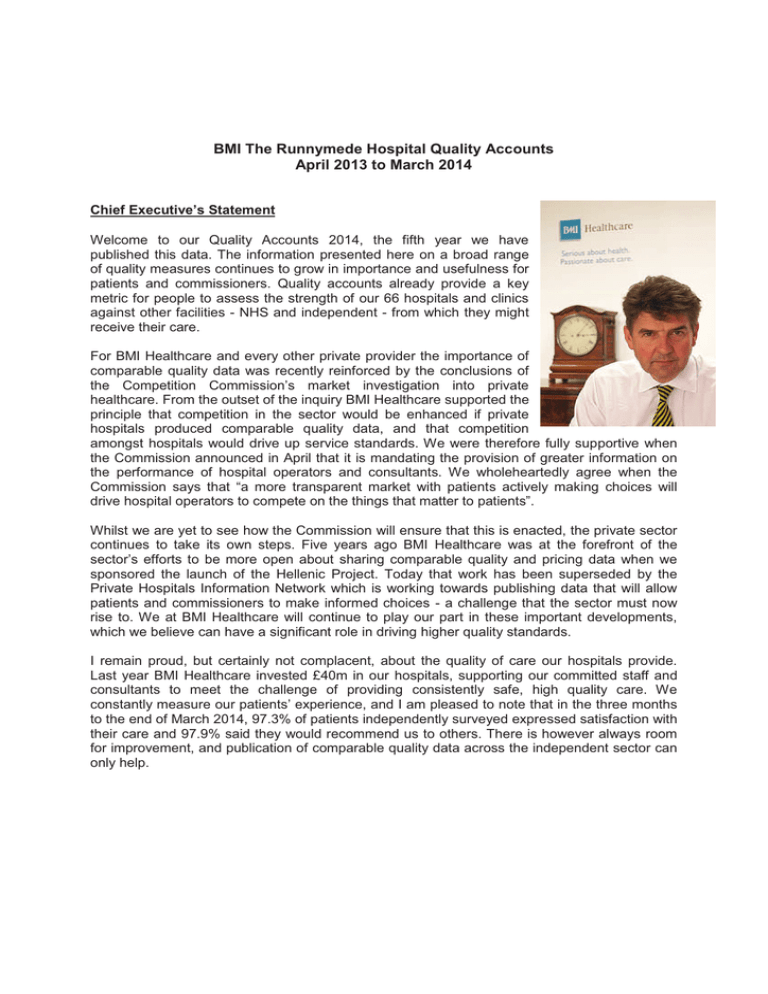
BMI The Runnymede Hospital Quality Accounts
April 2013 to March 2014
Chief Executive’s Statement
Welcome to our Quality Accounts 2014, the fifth year we have
published this data. The information presented here on a broad range
of quality measures continues to grow in importance and usefulness for
patients and commissioners. Quality accounts already provide a key
metric for people to assess the strength of our 66 hospitals and clinics
against other facilities - NHS and independent - from which they might
receive their care.
For BMI Healthcare and every other private provider the importance of
comparable quality data was recently reinforced by the conclusions of
the Competition Commission’s market investigation into private
healthcare. From the outset of the inquiry BMI Healthcare supported the
principle that competition in the sector would be enhanced if private
hospitals produced comparable quality data, and that competition
amongst hospitals would drive up service standards. We were therefore fully supportive when
the Commission announced in April that it is mandating the provision of greater information on
the performance of hospital operators and consultants. We wholeheartedly agree when the
Commission says that “a more transparent market with patients actively making choices will
drive hospital operators to compete on the things that matter to patients”.
Whilst we are yet to see how the Commission will ensure that this is enacted, the private sector
continues to take its own steps. Five years ago BMI Healthcare was at the forefront of the
sector’s efforts to be more open about sharing comparable quality and pricing data when we
sponsored the launch of the Hellenic Project. Today that work has been superseded by the
Private Hospitals Information Network which is working towards publishing data that will allow
patients and commissioners to make informed choices - a challenge that the sector must now
rise to. We at BMI Healthcare will continue to play our part in these important developments,
which we believe can have a significant role in driving higher quality standards.
I remain proud, but certainly not complacent, about the quality of care our hospitals provide.
Last year BMI Healthcare invested £40m in our hospitals, supporting our committed staff and
consultants to meet the challenge of providing consistently safe, high quality care. We
constantly measure our patients’ experience, and I am pleased to note that in the three months
to the end of March 2014, 97.3% of patients independently surveyed expressed satisfaction with
their care and 97.9% said they would recommend us to others. There is however always room
for improvement, and publication of comparable quality data across the independent sector can
only help.
The information available in these quality accounts has been reviewed by the Clinical
Governance Board and I declare that as far as I am aware the information contained in these
reports is accurate. I thank all the staff whose energy and devotion to improvement is
represented here and, more importantly, in the experiences of every patient who steps across
our threshold.
Stephen Collier
Chief Executive Officer
BMI The Runnymede Hospital is a purpose built 52-bedded private facility offering a full range of
surgical and medical services, with the benefit of extensive clinical support services. These
facilities, combined with the latest in technology and on-site support services, enable our
consultants to undertake a wide range of procedures from routine investigations to more
complex surgery.
The hospital has 3 theatres, 12 consulting rooms, imaging and physiotherapy departments and
is situated within the grounds of St Peter’s NHS Hospital, attached via a link corridor.
Our consultants are supported by caring and professional medical staff, including highly
qualified nursing teams and Resident Medical Officers (RMOs) 24 hours a day, ensuring the
highest quality care in a friendly and comfortable environment.
The Runnymede Hospital has on average 17% of NHS patients to its overall patient mix. The
hospital also works collaboratively with the local acute NHS trust servicing the Surrey NHS
community.
BMI Healthcare are registered as a provider with the Care Quality Commission (CQC) under the
Health & Social Care Act 2008. BMI Runnymede is registered as a location for the following
regulated services:·
·
·
Treatment of disease, disorder and injury
Surgical procedures
Diagnostic and screening
The CQC carried out an unannounced inspection on 1st August 2013 and found all 5 standards
assessed at the time of the inspection to be compliant, as listed below.
MET
Standards of treating people with respect and involving them in their
care
Standards of providing care, treatment & support which meets people's
needs
Standards of caring for people safely & protecting them from harm
Standards of staffing
Standards of management
The Runnymede Hospital has a local framework through which clinical effectiveness, clinical
incidents and clinical quality is monitored and analysed. Where appropriate, action is taken to
continuously improve the quality of care. This is through the work of a multidisciplinary group
and the Medical Advisory Committee.
Regional Clinical Quality Assurance Groups monitor and analyses trends and ensure that the
quality improvements are operationalised. There has been development of
At corporate level the Clinical Governance Board has an overview and provides the strategic
leadership for corporate learning and quality improvement.
There has been ongoing focus on robust reporting of all incidents, near misses and outcomes.
Data quality has been improved by ongoing training and database improvements. New reporting
modules have increased the speed at which reports are available and the range of fields for
analysis. This ensures the availability of information for effective clinical governance with
implementation of appropriate actions to prevent recurrences in order to improve quality and
safety for patients, visitors and staff.
At present we provide full, standardised information to the NHS, including coding of procedures,
diagnoses and co-morbidities and PROMs for NHS patients.There are additional external
reporting requirements for CQC, Public Health England (Previously HPA) CCGs and Insurers
BMI is a founding member of the Private Healthcare Information Network (PHIN) UK – where
we produce a data set of all patient episodes approaching HES-equivalency and submit this to
PHIN for publication. The data is made available to common standards for inclusion in
comparative metrics, and is published on the PHIN website http://www.phin.org.uk. This website
gives patients information to help them choose or find out more about an independent hospital
including the ability to search by location and procedure.
1. Safety
1.1 Infection prevention and control
The focus on infection prevention and control continues under
the leadership of the Group Head of Infection Prevention and
Control, in liaison with the link nurse in The Runnymede
Hospital.
The focus on infection prevention and control continues under
the leadership of the Group Director of Infection Prevention and
Control and Group Head of Infection Prevention and Control, in
liaison with the Infection Prevention and Control Lead The
Runnymede Hospital.
We have had: ·
Zero cases of MRSA bacteremia in the last year (NHS
1.17cases/100,000 bed days).
· Zero cases of MSSA bacteremia /100,000 bed days
· 1 E. Coli bacteremia case/ 100,000 bed days
· 1 hospital apportioned Clostridium difficile from 1.4.13 to 31.3.14
· Since 1.1.14 SSI data is also collected and submitted to Public Health England for
Orthopaedic surgical procedures – both hip and knee replacements.
The rate of
infection is as follows –
o Hips – 1 case – 0.02%
o Knee – 1 case – 0.02%
The hospital uses the Infection Prevention Society QIP audit tools to audit each
department/area within the hospital. Following the audit an action plan is generated, these are
reviewed at department meetings, followed up by the hospital infection prevention and control
lead. As well as being an agenda item at the quarterly hospital infection prevention and control
committee, the hospital DIPC and Consultant Microbiologist are in attendance.
The hospital completes quarterly High Impact Intervention Care Bundles in the following areas –
· Surgical Site Infections
· Urinary Catheters
· Peripheral Lines
· Central Lines
95% is the average score per quarter.
Annually the hospital completes the WHO hand hygiene self-assessment which we scored –
75% (intermediate). Quarterly hand hygiene audits are undertaken in different areas of the
hospital – average score 70%.
Environmental cleanliness is also an important factor in infection prevention and our patients
rate the cleanliness of our facilities highly.
1.2 Patient Led Assessment of the Care Environment (PLACE)
We believe a patient should be cared for with compassion and dignity in a clean, safe
environment. Where standards fall short, they should be able to draw it to the attention of
managers and hold the service to account. PLACE assessments will provide motivation for
improvement by providing a clear message, directly from patients, about how the environment
or services might be enhanced.
In 2013 we introduced PLACE, which is the new system for assessing the quality of the patient
environment, replacing the old Patient Environment Action Team (PEAT) inspections.
The assessments involve patients and staff who assess the hospital and how the environment
supports patient’s privacy and dignity, food, cleanliness and general building maintenance. It
focuses entirely on the care environment and does not cover clinical care provision or how well
staff are doing their job.
PLACE
Cleanliness
Food
Privacy, Dignity & Wellbeing
Condition, Appearance &
Maintenance
2013
%
96.9
94.79
76.47
86.14
Following the review in 2013 some improvements were made to the internal signage for patients
& visitors which were addressed with extra signs purchased and installed. A programme of
redecoration of patient bedrooms and general areas followed; storage was installed within the
lobby area of theatres to improve the initial impact for patients entered the department.
1.3 Venous Thrombo-embolism (VTE)
BMI Healthcare, holds VTE Exemplar Centre status by the Department of Health across its
whole network of hospitals including, The Runnymede Hospital. BMI Healthcare was awarded
the Best VTE Education Initiative Award category by Lifeblood in February 2013 and were the
Runners up in the Best VTE Patient Information category.
We see this as an important initiative to further assure patient safety and care. We audit our
compliance with our requirement to VTE risk assessment every patient who is admitted to our
facility and the results of our audit on this has shown the hospital average is 95-100%. This is
monitored monthly by the Director of Clinical Services.
The Runnymede Hospital reports the incidence of Venous Thromboembolism (VTE) through the
corporate clinical incident system. It is acknowledged that the challenge is receiving information
for patients who may return to their GPs or other hospitals for diagnosis and/or treatment of VTE
post discharge from the Hospital. As such we may not be made aware of them. We continue to
work with our Consultants and referrers in order to ensure that we have as much data as
possible. See below DVT rate per 100 admissions
2. Effectiveness
2.1 Patient reported Outcomes (PROMS)
Patient Reported Outcome Measures (PROMs) are a means of collecting information on the
effectiveness of care delivered to NHS patients as perceived by the patients themselves.
PROMs is a Department of Health led programme.
The hospital ensures all eligible NHS patients are encouraged to complete the PROMs
questionnaire prior to admission, asking at the Pre-assessment appointment, however the
numbers of patients eligible at The Runnymede, are extremely low. This has resulted in no
Hospital data being available in the annual results for the Oxford Hip Score.
Oxford Hip Score average
April 12 –
Mar 13
Q1
Q2
Runnymede
Hospital
Health gain between reporting
periods
No data available
17.907
39.224
21.317
England
Copyright © 2011 Re-used with the permission of The Health and Social Care Information Centre. All rights reserved.'
Oxford Knee Score average
April 12 –
Mar 13
Runnymede
Hospital
Q1
Q2
Health gain between reporting
periods
27.833
36.5
8.667
18.893
34.902
16.01
England
Copyright © 2013, The Health and Social Care Information Centre. All Rights Reserved.
2.2 Enhanced Recovery Programme (ERP)
The ERP is about improving patient outcomes and speeding up a patient’s recovery after
surgery. ERP focuses on making sure patients are active participants in their own recovery and
always receive evidence based care at the right time. It is often referred to as rapid recovery, is
a new, evidence-based model of care that creates fitter patients who recover faster from major
surgery. It is the modern way for treating patients where day surgery is not appropriate.
The Runnymede have organised for corporate leads on this project to run a work shop in May to
support staff in the full implementation of this programme. Current plans for 2014 will be to
formulate a working group that will consist of a staff member from each clinical department.
The launch is planned for mid-June 2014
Over next couple of months to also increase the number of pre assessment clinics we run to
include weekends.
2.3 Unplanned Readmissions within 31 days and unplanned returns to theatre.
Unplanned readmissions and unplanned returns to theatre are normally due to a clinical
complication related to the original surgery.
3. Patient experience
3.1 Patient satisfaction
BMI Healthcare is committed to providing the highest levels of quality of care to all of our
patients. We continually monitor how we are performing by asking patients to complete a patient
satisfaction questionnaire. Patient satisfaction surveys are administered by an independent third
party.
TOTAL PATIENTS
BMI The Runnymede Hospital
2013
2012
Responses
1138
1552
Arrival process
Consultant / Anaesthetist
Consultant Surgeon / Physician
Nursing care
94.9
95.6
98.5
96.2
94.8
94.9
98.4
95.6
Accommodation
Catering
Discharge procedure
Quality of care
Met / exceeded expectation
Recommendation (definitely + probably)
94.1
94.4
89.5
98.2
98.2
99.0
94.3
92.2
87.8
97.2
98.6
98.9
The Runnymede Hospital holds regular Quality meetings with full terms of reference and
representatives from each department throughout the hospital and this forum reviews results of
patient feedback reports and identifies areas for action. The hospital also has Operational
Excellence Standards in place which support a standardised best practice approach to shaping
its customer care through training and developing its staff.
3.2 Complaints
In addition to providing all patients with an opportunity to complete a satisfaction survey BMI
Runnymede Hospital actively encourages feedback both informally and formally. Patients are
supported through a robust complaints procedure, operated over three stages:
Stage 1: Hospital resolution
Stage 2: Corporate resolution
Stage 3: Patients can refer their complaint to independent adjudication if they are not satisfied
with the outcome at the other 2 stages.
The above table indicates written complaints per 100 admissions – the main themes during this
period being around:
·
·
·
·
Financial
Nursing
Consultants and Other Health professionals
Other
4. CQUINS
The local CQUINs established by North West Surrey CCG with The Runnymede
Hospital were well established and a system put in place within the hopsital for
capturing the CQUIN data.
As a result the following was achieved in 2013/14
Friends and Family
The response rate has increased significantly over the tweleve month period from 8% in
April 13 to 17-22% in the last quarter.
VTE
VTE risk assessments on admission is a National CQUIN the Runnymede is currently
averaging between 95-100%. This is audited monthly and reported back to teams were
there are areas for improvement.
GP Communication – there has been significant progress made during the last year to
send by secure e-mail the Discharge Summary to the GP within 24 hours the average is
now 98%. Previous this had been posted, so could take several days for the GP to have
the information regarding discharge medications, wound care specifics and follow up
plans. The quality of the communication is also captured which 100% has been
achieved. There have been no complaints from local GPS on quality or speed of
communications.
Patient Safety Thermometer
The patient safety thermometer data is submitted monthly, there have been no incidents
of pressure ulcers, VTE, falls, Urinary tract infections in the monthly data submitted.
5. National Clinical Audits
The Runnymede was only eligible to participate in National Joint Registry audit and all joint
replacements are submitted to this. BMI hospital data is from page 196 onwards in attached
latest NJS report. Use this if appropriate with your narrative on the data and any improvement
plans.
6. Research
No NHS patients were recruited to take part in research.
7. Priorities for service development and improvement
A major priority is the expansion of capacity and services at the hospital in order to meet
growing demand. This includes undertaking a feasibility study for the provision of additional
operating theatre capacity at the hospital through the physical extension of the existing space.
Extended provision of diagnostic radiology is also under consideration.
Priorities for quality improvement for 2014/15 are:
·
·
·
Patient Satisfaction scores – focus on further improvement in both our response rate
from patients, particularly outpatients, and on improvement in the scores across all
areas. Significant improvements have been made since 2013/14. Progress will be
monitored through our independently operated patient satisfaction survey results. At the
end of 2013/13 an overall satisfaction score of 98.9% was achieved
Enhanced Recovery Programme – covered in 2.2.
Operational Excellence / PLACE audits – internal and external reviews respectively of
our environment in which patients are treated. PLACE audit scores for 2013 are in 1.2
above and 2014 scores are not yet available. Both are a key quality priority for 2014/15
to evidence a continued improvement in the patient environment.
8. Mandatory Quality Indicators
8.1 The value and banding of the summary hospital-level mortality indicator (SHMI) for the
Runnymede Hospital for the reporting period.
Unit
Value
and
Banding
Reporting Periods
(at least last two
reporting periods)
April 2013- March 2014
National
Average
0.219
Highest National
Score
0.473
Lowest National
Score
0.219
The Runnymede Hospital considers that this data is as described for the following reasons:
· There have been no outbreaks of infection
· Mortality rate not excessive and no unexplained deaths. 3 expected deaths and 1
unexpected.
· The hospital has not sustained a Never Event
The Runnymede hospital will continue to monitor and make improvements to the quality of
patient care, including ending of life care.
8.2 The Runnymede patient reported outcome measures scores for
(i) Groin hernia surgery
Unit
Number
Reporting Periods
(at least last two
reporting periods)
April 2013- March 2014
National
Average
1
Highest National
Score
1
Lowest National
Score
0
The Runnymede hospital considers that this data is as described for the following reasons:
· 1 patient re-admitted with wound infection.
· No returns to theatre
The Runnymede Hospital will continue to monitor patient safety and so the quality of its
services, by review of hospital infection rates; re-admission rates and returns to theatre.
(ii) Varicose vein surgery
Unit
Number
Reporting Periods
(at least last two
reporting periods)
April 2013- March 2014
National
Average
0%
Highest National
Score
0%
Lowest National
Score
0%
The Runnymede considers that this data is as described for the following reasons:
· No patients were infected post-surgery and none were re-admitted
The Runnymede Hospital will continue to monitor infection rates, returns to theatre and readmissions and so the quality of its services, by review of incident data.
(iii) Hip replacement surgery
Unit
Number
Reporting Periods
(at least last two
reporting periods)
April 2013- March 2014
National
Average
0%
Highest National
Score
0.273384105
Lowest National
Score
0
The Runnymede considers that this data is as described for the following reasons:
· No reported hip replacement infections or dislocations
The Runnymede Hospital will continue to monitor the quality of patient care alongside the
incident rate, and so the quality of its services, by review of data at the Hospital Clinical
governance Committee.
Knee replacement surgery during the reporting period.
Unit
Number
Reporting Periods
(at least last two
reporting periods)
April 2013- March 2014
National
Average
0.223713647
Highest National
Score
0.334448161
Lowest National
Score
0
The Runnymede Hospital considers that this data is as described for the following reasons:
· No infection reported
· No unplanned re-admissions post-surgery.
The Runnymede Hospital continues to monitor accident and incident rates including readmission at the Hospital clinical governance Committee. The quality of care remains at 98.87%
8.3 (i) The percentage of patients aged 0-14 readmitted to a hospital which forms part of the
Runnymede Hospital within 28 days of being discharged from a hospital which forms part of the
hospital during the reporting period.
Unit
%
Reporting Periods
(at least last two
reporting periods)
April 2013- March 2014
National
Average
0%
Highest National
Score
0%
Lowest National
Score
0%
The Runnymede considers that this data is as described for the following reasons as the
hospital has had no pediatric re-admissions.
The Runnymede Hospital will continue to monitor the quality of services to pediatrics via the
Hospital Clinical Governance Committee.
8.3.(ii)The percentage of patients aged 15 or over readmitted to a hospital which forms part of
the Runnymede within 28 days of being discharged from a hospital which forms part of the
hospital during the reporting period.
Unit
%
Reporting Periods
(at least last two
reporting periods)
April 2013- March 2014
National
Average
0.0004293%
Highest National
Score
0.242
Lowest National
Score
0.00
The Runnymede Hospital considers that this data is as described for the following reasons:
· All re-admissions are recorded on an adverse occurrence form and reviewed at the
Hospital Clinical governance Committee
The Runnymede Hospital will continue to monitor the quality of care given to patients alongside
the adverse occurrence rate at the Hospital Clinical Governance Committee.
8.4 The Runnymede Hospital responsiveness to the personal needs of its patients during the
reporting period.
Unit
%
Reporting Periods
(at least last two
reporting periods)
April 2013- March 2014
National
Average
96.89%
Highest National
Score
97.21%
Lowest National
Score
90.0%
The Runnymede Hospital considers that this data is as described for the following reasons:
· Staffing levels remain within the agreed key performance indicators.
The Runnymede Hospital will continue to monitor staff levels and so the quality of its services,
by active recruitment of new trained and health care assistants supported by the ward
administrators.
8.5 The percentage of patients who were admitted to the Runnymede Hospital and who were
risk assessed for venous thromboembolism during the reporting period.
Unit
90%
Reporting Periods
(at least last two
reporting periods)
April 2013- March 2014
National
Average
90%
Highest National
Score
100%
Lowest National
Score
20%
The Runnymede Hospital considers that this data is as described for the following reasons:
· All patient care pathways contain a risk assessment for venous thromboembolism, and
form part of the admission process.
The Runnymede Hospital will take the following actions to improve this:
· The hospital will ensure that all patients are assessed and appropriate action taken in
relation to the risk score and so the quality of its services, by provision of adequate
training for staff
· The provision of a VTE Lead Nurse
8.6 The rate per 100,000 bed days of cases of C difficile infection reported within the
Runnymede Hospital amongst patients aged 2 or over during the reporting period.
Unit
Rate
0.23%
Reporting Periods
(at least last two
reporting periods)
April 2013- March 2014
National
Average
0.411353353
Highest National
Score
280.112
Lowest National
Score
0.000
The Runnymede Hospital considers that this data is as described for the following reasons:
· The hospital had two separate occasions of patients admitted with diarrhea which was
diagnosed as clostridium difficile- one of which was attributed to the community and the
other overzealous use of antibiotics.
The Runnymede Hospital will take the following actions to improve this:
· Review of any patient who is reported as having diarrhea or loose stools prior to
admission with a view to refusing admission if felt appropriate.
· Those diagnosed with C. difficile will continue to be nursed in source isolation’
and so the quality of its services, by review of incident data at the Hospital clinical governance
committee.
8.7 The number and, where available, rate of patient safety incidents reported within the
Runnymede Hospital during the reporting period, and the number and percentage of such
patient safety incidents that resulted in severe harm or death.
Number of patient safety incidents reported
Unit
Number
Reporting Periods
(at least last two
reporting periods)
April 2013- March 2014
National
Average
2
Highest National
Score
2
Lowest National
Score
0
Rate of patient safety incidents reported
Unit
Rate
Reporting Periods
(at least last two
reporting periods)
April 2013- March 2014
National
Average
0.98%
Highest National
Score
2.547%
Lowest National
Score
0.000%
Number of patient safety incidents that resulted in severe harm or death
Unit
Number
Reporting Periods
(at least last two
reporting periods)
April 2013- March 2014
National
Average
0
Highest National
Score
0
Lowest National
Score
0
Percentage of patient safety incidents that resulted in severe harm or death
Unit
%
Reporting Periods
(at least last two
reporting periods)
April 2013- March 2014
National
Average
0%
Highest National
Score
0%
Lowest National
Score
0%
The Runnymede Hospital considers that this data is as described for the following reasons:
· The nursing team organized a fall prevention group which met regularly to look at ways
of preventing patient falls. This has included purchasing an alarm mattress and
reviewing the location for nursing these patients. The group was multi-disciplinary
including physiotherapy.
The Runnymede Hospital have taken the following actions to improve the rate from 2012-2013
by 50% and so the quality of its services, by the introduction of the falls mattress alarm, the
purchase of a high low bed and locating at risk patients nearer to the nursing station.
8.8 The percentage of staff employed by The Runnymede Hospital during the reporting period,
who would recommend The Runnymede Hospital as a provider of care to their family or friends
in 93% (extremely likely or likely).
The Runnymede Hospital considers that this data is as described as taken from an anonymous
questionnaire completed by 64% of staff members
The Runnymede Hospital will discuss these results, along with patient satisfaction feedback,
through its Quality Board Meeting to ensure necessary actions are taken improve in the required
areas and, therefore, the quality of its services overall.
9. Non-Mandatory Quality Indicators
9.1 The percentage of patients who received care as inpatients or discharged from The
Runnymede Hospital during the reporting period, who would recommend the Runnymede
Hospital as a provider of care to their family or friends.
Unit
79.81
Reporting Periods
(at least last two
reporting periods)
April 13 – March 14
National
Average
Highest National
Score
Lowest National
Score
81.81
91.36
71.45
The Runnymede Hospital actively encourages feedback both informally and formally. On a
daily basis the on-call Senior Manager visits five patients due for discharge to ascertain that the
service they have received have met their standards, to ensure that there are no issues that can
be resolved before departure and finally to encourage the completion of the satisfaction
questionnaire.

